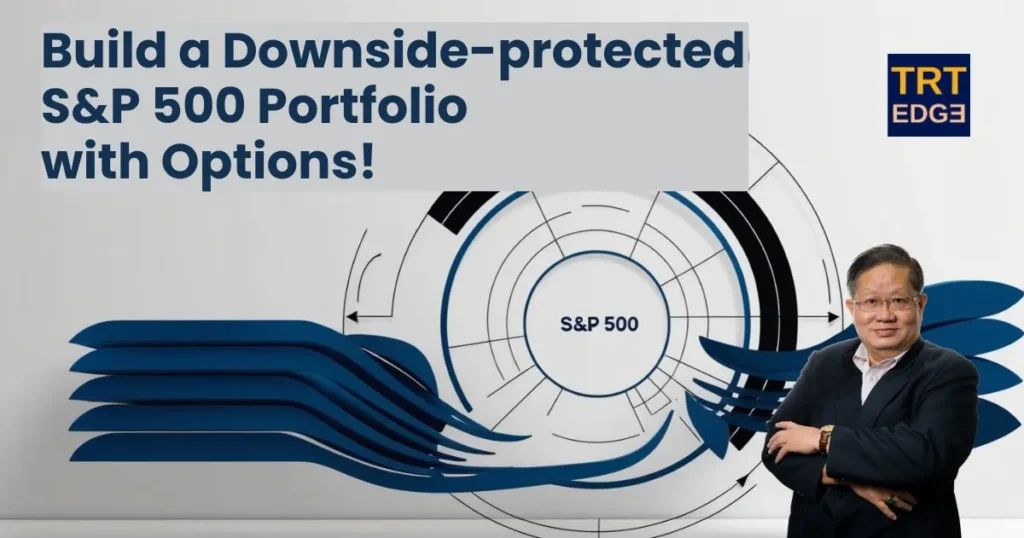Build a Downside-protected S&P 500 Portfolio with Options!

Introduction to Downside-protected S&P 500 Portfolio
Investing in the S&P 500 has historically been a reliable way to build wealth, with the index averaging an annual return of around 10% over the long term. However, market volatility and economic downturns can lead to short-term losses that might concern investors, especially those nearing retirement or with lower risk tolerance. Fortunately, you can use options to build a downside-protected S&P 500 portfolio, balancing growth potential while limiting losses. This strategy blends the growth of equities with the flexibility and risk management power of options.
In this blog, we will explore how to use options to protect your S&P 500 portfolio, discuss key strategies, and review their pros and cons.
Understanding Options Basics
Before diving into the strategies, let’s briefly go over what options are:
- Call options give the holder the right (but not the obligation) to buy an asset at a specified price within a certain timeframe.
- Put options give the holder the right (but not the obligation) to sell an asset at a specified price within a certain timeframe.
In this context, we’ll be focusing on put options to hedge your downside risk in an S&P 500 portfolio, and call options to limit costs in more complex strategies.

Why Use Options for Downside Protection?
- Limiting Losses: Options allow investors to protect their portfolios against large drops in value, providing peace of mind during market downturns.
- Flexibility: Options are highly customizable, allowing you to tailor protection for specific timeframes and levels of risk.
- Cost-Effectiveness: Some strategies can offer protection at a fraction of the cost compared to simply selling shares or shifting entirely to bonds.
Key Strategies for Downside Protection
1. Protective Put Strategy
The protective put is one of the simplest and most effective ways to limit downside risk. In this strategy, you own shares of the S&P 500 (e.g., through an ETF like SPY) and buy put options on that same position.
- How it works: You purchase a put option at a strike price below the current market price. If the S&P 500 drops below the strike price, your put option will increase in value, offsetting some of the losses from your stock position.
- Example: Assume the S&P 500 ETF (SPY) is trading at $450, and you want to protect yourself from a decline. You can purchase a 3-month put option with a strike price of $420. If the market falls to $400, the put option gains value, reducing your losses.
- Pros: Provides straightforward, efficient protection for a modest premium.
- Cons: If the market doesn’t decline, the cost of the put reduces your total returns.
2. Collar Strategy
The collar strategy is a more cost-effective version of the protective put, designed to cap both losses and gains. Here, you hold an S&P 500 position, buy a put option to limit downside, and simultaneously sell a call option to limit upside.
- How it works: You buy a put option with a strike price below the current market price and sell a call option with a strike price above the current price. The premium received from the call helps offset the cost of the put.
- Example: Let’s say SPY is at $450. You could buy a put at $420 and sell a call at $480. If the market declines below $420, your put limits losses, but if it rises above $480, your gains are capped by the call.
- Pros: Low-cost or even no-cost protection; customizable to your risk preferences.
- Cons: Caps potential upside gains, which can limit returns in a strong bull market.
3. Put Spread Strategy
The put spread is a slightly more advanced approach to hedging downside risk. Instead of buying a single put option, you buy one put option and simultaneously sell another put at a lower strike price.
- How it works: You buy a put option at a strike price close to the current market price (for example, $450) and sell a put option at a lower strike price (for example, $420). This creates a range in which you’re protected from losses but not beyond the lower strike price.
- Example: You buy a put with a strike price of $450 and sell a put with a strike price of $420. If the S&P 500 falls below $450, you start to benefit from your long put. However, your maximum protection is limited to $420, where the short put offsets the gain from your long put.
- Pros: Cheaper than buying outright puts; limits loss while reducing cost.
- Cons: Limited protection if the market drops significantly below the lower strike price.
Factors to Consider Before Using Options for Downside Protection
- Cost: Protective options, especially when bought during times of high volatility, can be expensive. While strategies like collars and put spreads can reduce costs, they come with trade-offs.
- Market Outlook: If you expect only a mild decline or a flat market, basic protective puts may be overkill. Consider whether the cost of protection aligns with your market forecast.
- Time Horizon: Options have expiration dates. You’ll need to choose between short-term or long-term protection, depending on your investment goals.
- Risk Tolerance: Some strategies, like collars, cap your upside. Make sure you’re comfortable with the balance between protection and potential gains.
Conclusion
Building a downside-protected S&P 500 portfolio with options can offer peace of mind during turbulent markets while keeping you exposed to potential upside gains. Strategies like protective puts, collars, and put spreads provide different levels of protection, each with its trade-offs in terms of cost and potential upside.
The right strategy for you depends on your risk tolerance, market outlook, and investment horizon. By leveraging options, you can navigate the market with greater confidence, knowing that your portfolio has a safety net in place.

Are you ready to start protecting your S&P 500 portfolio with options? Contact us for a trade-to-learn experience!







